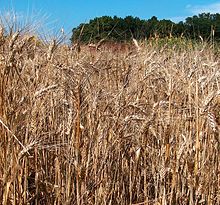Durum
| Durum | |
|---|---|
 |
|
| Durum wheat | |
| Scientific classification | |
| Kingdom: | Plantae |
| (unranked): | Angiosperms |
| (unranked): | Monocots |
| (unranked): | Commelinids |
| Order: | Poales |
| Family: | Poaceae |
| Subfamily: | Pooideae |
| Tribe: | Triticeae |
| Genus: | Triticum |
| Species: | T. durum |
| Binomial name | |
|
Triticum durum Desf. |
|
| Synonyms | |
|
List
|
|
Durum wheat,pasta wheat or macaroni wheat (Triticum durum or Triticum turgidum subsp. durum) is the only tetraploid species of wheat of commercial importance that is widely cultivated today. It was developed by artificial selection of the domesticated emmer wheat strains formerly grown in Central Europe and the Near East around 7000 BC, which developed a naked, free-threshing form. Like emmer, durum wheat is awned. It is the predominant wheat that grows in the Middle East.
Durum in Latin means "hard", and the species is the hardest of all wheats. This refers to the resistance of the grain to milling, in particular of the endosperm, implying dough made from its flour is weak or "soft". This makes durum favorable for semolina production and less practical for flour production which requires more work than with hexaploid wheats like common bread wheats. Despite its high protein content, durum is not a strong wheat in the sense of giving strength to dough through the formation of a gluten network. Durum contains 27% extractable, wet gluten, about 3% higher than in common wheat (T. aestivum L.).
Durum wheat is a tetraploid wheat, having 28 chromosomes, unlike hard red winter and hard red spring wheats, which are hexaploid and have 42 chromosomes each.
Durum wheat originated through intergeneric hybridization and polyploidization involving two diploid grass species: T. urartu (2n = 2x = 14, AA genome) and a B-genome diploid related to Aegilops speltoides (2n = 2x = 14, SS genome) and is thus an allotetraploid species.
...
Wikipedia
